Powder-actuated tool
A powder-actuated tool (PAT, often generically called a Hilti gun or a Ramset gun after their manufacturing companies) is a type of nail gun used in construction and manufacturing to join materials to hard substrates such as steel and concrete. Known as direct fastening, this technology is powered by a controlled explosion of a small chemical propellant charge, similar to the process that discharges a firearm.
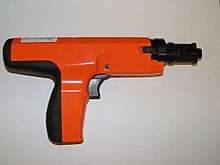
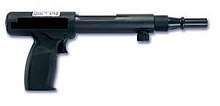
Description
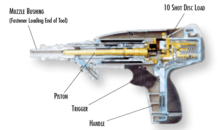
Powder-actuated tools are often used because of their speed of operation, compared to other processes such as drilling and then installing a threaded fastener. They can more easily be used in narrow or awkward locations, such as installing steel suspension clips into an overhead concrete ceiling.
Powder-actuated tools are powered by small explosive cartridges, which are triggered when a firing pin strikes a primer, a sensitive explosive charge in the base of the cartridge. The primer ignites the main charge of powder, which burns rapidly. The hot gases released by the burning of the propellant rapidly build pressure within the cartridge, which pushes either directly on the head of the fastener, or on a piston, accelerating the fastener out of the muzzle.
Powder-actuated tools come in high-velocity and low-velocity types. In high-velocity tools, the propellant charge acts directly on the fastener in a process similar to a firearm. Low-velocity tools introduce a piston into the chamber. The propellant acts on the piston, which then drives the fastener into the substrate. The piston is analogous to the bolt of a captive bolt pistol.
A tool is considered low velocity if the average test velocity of the fastener is not in excess of 100 m/s (330 ft/s) with no single test having a velocity of over 108 m/s (350 ft/s). High-velocity tools may not be made or sold in the United States; however, some made decades ago are still in use in the shipbuilding and steel industries.
Powder-actuated fasteners are made of special heat-treated steel; common nails are unsafe for this application. There are many specialized fasteners designed for specific applications in the construction and manufacturing industries.
The main manufacturers of powder actuated tools are Ramset, Hilti, Powers/DeWalt, Tomarco, and Simpson Strong Tie.
History
Powder-actuated technology was developed for commercial use during the Second World War, when high-velocity fastening systems were used to temporarily repair damage to ships. In the case of hull breaches, these tools fastened steel plates over damaged areas.[1] These tools were developed by Mine Safety Appliances, for the United States Navy.[2] Powder-actuated tools were investigated and used prior to this development; they were used in submarine hunting during the First World War and were the subject of a 1921 United States patent (US Patent No. 1365869).[3]
Types of tools
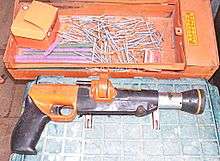
Powder actuated tools can be variously classified:
- Direct acting (the charge acts directly on the head of the nail or high velocity), or indirect (using an intermediate piston or low velocity)
- Single-shot, or magazine-fed
- Automatic or manual piston cycling
- Automatic or manual feed of the charges
Energy sources
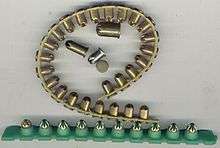
Powder-actuated tools are powered by specially-designed blank firearm cartridges, also informally called "loads", "boosters", "rounds", or "charges".
In many cases, the charges are ordinary firearm cartridges with modified casings, and the bullets omitted. The .22 Short, developed by Smith & Wesson, is common. These charges may be hand-fed (single-shot), or manufactured and distributed on a plastic carrier strip.
Color coding
| Color coding | Velocity |
|---|---|
| Gray | 315 ft/s (96 m/s) |
| Brown | 385 ft/s (117 m/s) |
| Green | 490 ft/s (150 m/s) |
| Yellow | 575 ft/s (175 m/s) |
| Red | 675 ft/s (206 m/s) |
| Purple | 755 ft/s (230 m/s) |
| Color coding | Velocity |
|---|---|
| Gray | 845 ft/s (258 m/s) |
| Brown | 935 ft/s (285 m/s) |
| Green | 1,025 ft/s (312 m/s) |
| Yellow | 1,115 ft/s (340 m/s) |
| Red | 1,205 ft/s (367 m/s) |
| Purple | 1,295 ft/s (395 m/s) |
The three single-shot strengths or colors typically sold to the general public are brown, green, and yellow in brass-colored casings.
Not all powder-actuated tools are rated for high-capacity charges — the strongest charge (nickel-purple at 1,295 ft/s (395 m/s)), for example, is dangerous in a tool not rated for the high pressures it generates. The table above is for a 350 grains (23 g) slug from a test device.
Safety and regulation
As with their air-actuated cousins, powder-actuated guns have a muzzle safety interlock. If the muzzle is not pressed against a surface with sufficient force, the firing pin is blocked and cannot reach the load to fire it. This helps ensure that the gun does not discharge in an unsafe manner, causing the nail to become an unrestrained projectile.
Due to their potential for causing personal injury, OSHA regulations in the US require certification specific to the tool being used before any person is permitted to rent or use powder-actuated equipment.[4] Most manufacturers of powder-actuated nail guns offer training and certification, some with free online testing. In addition, special instruction is necessary if the prospective user is unable to distinguish colors used in the color code system that identifies proper power levels. Most certifications are accepted for life; however, in California they must be renewed every three years.[5]
The ownership and use of these tools is regulated in Australia. The owner has to register the tool, and an operator of one of these tools is required to have a license and to have undergone training in their use. These laws are in keeping with Australia's extremely strict firearm laws.
Powder-actuated fasteners
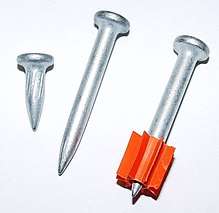

The fasteners used in powder-actuated tools are not common nails. Instead, they are manufactured from special steel and are heat-treated to produce a very hard yet ductile fastener. These properties permit the fastener to penetrate concrete or steel without breaking.
Unlike some threaded fasteners, powder-actuated fastening results in a permanently-installed attachment. These types of fasteners generally cannot be removed without damage to the fastener and the surface where it is attached.
Every fastener must be equipped with some type of washer, eyelet, sleeve, or other guide member at its tip. This guide member aligns the fastener in the tool as it is being driven, and is commonly used to retain the fastener in the tool until it is installed.
Common fasteners
There are two common powder-actuated fasteners:
- Drive pin - A drive pin is a special nail-like fastener designed to permanently attach one material to another, such as wood to concrete or wood to steel. Head diameters vary in size from 1⁄4 to 3⁄8 in (6.4 to 9.5 mm). However, to spread the load when driven through soft materials, washers or discs of larger diameters are either driven through, or made part of a pre-assembled drive pin configuration. This helps prevent "overdriving" the fastener too far into the fastened material.
- Threaded stud - A threaded stud is a fastener consisting of a shank portion which is driven into the base material (and is therefore not visible after fastening), plus a threaded portion which remains visible after the fastening. An object is then attached to the threaded portion with a nut. The most common thread sizes are 1/4-20, and 3/8-16.
Fasteners for special applications
There are also other types of fastener assemblies designed for specific applications. Examples include:
- Breakaway fasteners - For temporary fastening of wood forming to concrete, designed to break away after forms are removed
- Weathered fasteners - Typically used to attach lumber to steel or concrete
- Magazine fasteners - These are strip collated fasteners for magazine-fed tools
- Steel deck fasteners - Used to attach corrugated metal deck to bar joist or I-beam
- Conduit clips - Used to attach EMT conduit to concrete, masonry, or steel
- Ceiling clips - Typically used by ceiling contractors to install suspended ceilings
- Road basket clips - Used to secure re-bar baskets in highway construction and paving
See also
References
- "Engineering maintenance". Hospital Management. 90: 52. 1960.
- "Powder-actuated driver". The Signalman's Journal. 29–30. 1948.
- "Powder-actuated fasteners". Engineering Journal. 40–41: 99. 2003.
- Use of Powder Actuated Tools Requires Training and Certification
- [http://www.rentalmanagementmag.com/Art/tabid/232/ArticleId/8108 What you need to know about POWDER-ACTUATED TOOLS